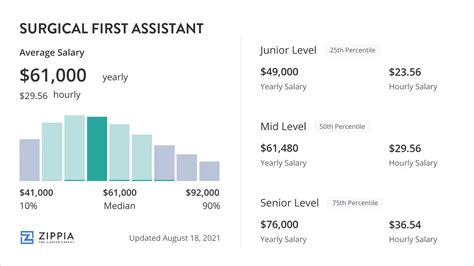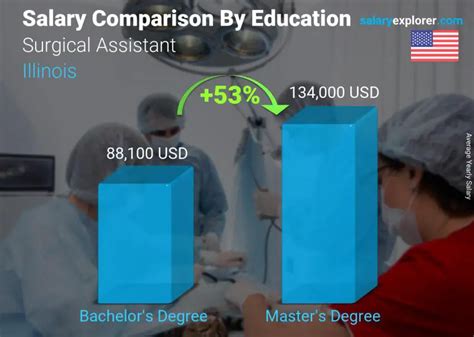Intro
The role of a Surgical First Assistant (SFA) has become increasingly important in the medical field, providing critical support to surgeons and anesthesiologists during surgical procedures. As the demand for SFAs continues to rise, so does the interest in understanding their compensation and job responsibilities. In this article, we will delve into the average salary of a Surgical First Assistant, as well as provide insights into the job requirements, growth prospects, and education needed to pursue this career.

What is a Surgical First Assistant?
A Surgical First Assistant is a medical professional who plays a vital role in the operating room, working closely with surgeons, anesthesiologists, and other healthcare professionals to ensure the smooth execution of surgical procedures. SFAs are responsible for preparing patients for surgery, maintaining a sterile environment, and providing hands-on assistance to surgeons during operations. They may also be involved in pre-operative and post-operative care, as well as assisting with patient recovery.
Key Responsibilities of a Surgical First Assistant
Some of the key responsibilities of a Surgical First Assistant include:
- Preparing patients for surgery, including positioning and prepping the skin
- Maintaining a sterile environment and adhering to infection control protocols
- Assisting surgeons during procedures, including retracting tissue, cutting sutures, and handling surgical instruments
- Monitoring patients' vital signs and alerting the surgical team to any changes or concerns
- Assisting with patient recovery and post-operative care
Surgical First Assistant Salary: Average Pay and Variations
The salary of a Surgical First Assistant can vary depending on factors such as location, experience, and education. According to the Bureau of Labor Statistics (BLS), the median annual salary for SFAs in the United States was around $67,000 in May 2020. However, salaries can range from around $45,000 to over $90,000 per year, depending on the specific job and location.

Salary Variations by Location
Salaries for SFAs can vary significantly depending on the location. For example:
- SFAs working in urban areas tend to earn higher salaries, with median salaries ranging from $70,000 to over $100,000 per year.
- SFAs working in rural areas may earn lower salaries, with median salaries ranging from $50,000 to $70,000 per year.
- SFAs working in states with a high cost of living, such as California or New York, may earn higher salaries to compensate for the increased cost of living.
Education and Training Requirements
To become a Surgical First Assistant, one typically needs to complete a formal education program in surgical technology or a related field. Many SFAs hold an associate's degree or certificate in surgical technology, and some may also hold a bachelor's degree in a related field.

Certification and Licensure
While certification and licensure requirements for SFAs vary by state, many employers prefer or require SFAs to be certified. The National Board of Surgical Technology and Surgical Assisting (NBSTSA) offers certification for SFAs, which can demonstrate expertise and commitment to the profession.
Job Outlook and Growth Prospects
The demand for Surgical First Assistants is expected to grow significantly in the coming years, driven by an aging population and an increased need for surgical procedures. According to the BLS, employment of SFAs is projected to grow 3% from 2020 to 2030, faster than the average for all occupations.

Emerging Trends and Opportunities
The field of surgical technology is constantly evolving, with new technologies and techniques being developed to improve patient outcomes and reduce recovery times. SFAs who stay up-to-date with the latest developments and advancements in the field may have opportunities for career advancement and increased earning potential.
Conclusion
In conclusion, the role of a Surgical First Assistant is a critical one, requiring a unique blend of technical skills, attention to detail, and compassion. While salaries for SFAs can vary depending on location and experience, the median salary for SFAs in the United States is around $67,000 per year. With the demand for SFAs expected to grow in the coming years, those interested in pursuing this career should be prepared to complete a formal education program in surgical technology or a related field, and stay up-to-date with the latest developments and advancements in the field.
We invite you to share your thoughts and experiences as a Surgical First Assistant in the comments below. What do you think are the most important skills and qualities for success in this role? How do you see the field of surgical technology evolving in the coming years?
What is the average salary for a Surgical First Assistant in the United States?
+The median annual salary for SFAs in the United States was around $67,000 in May 2020, according to the Bureau of Labor Statistics.
What education and training are required to become a Surgical First Assistant?
+To become a Surgical First Assistant, one typically needs to complete a formal education program in surgical technology or a related field. Many SFAs hold an associate's degree or certificate in surgical technology, and some may also hold a bachelor's degree in a related field.
Is certification required to work as a Surgical First Assistant?
+While certification and licensure requirements for SFAs vary by state, many employers prefer or require SFAs to be certified. The National Board of Surgical Technology and Surgical Assisting (NBSTSA) offers certification for SFAs, which can demonstrate expertise and commitment to the profession.
